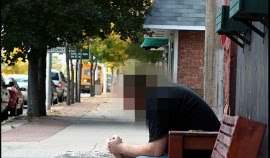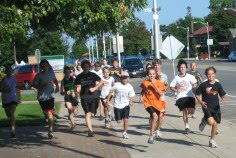 Net-Zero Energy Building for the Homeless Introduced at The Salvation Army Home Run
Net-Zero Energy Building for the Homeless Introduced at The Salvation Army Home Run
by Bobbie Stacey - Founder of Home Run Innovations Inc.
On May 23, 2009, designers and architects, Ryan Brayak, Kevin Bell and Hannah Jackson introduced conceptual plans for a net-zero energy building in downtown Escanaba that will be used temporarily for emergency and transitional housing of the homeless in Delta County.
The building is part of a three-part plan by Home Run Innovations Inc. to revitalize communities by creating a financially self-sustainable housing program. Part one is to create sustainable income streams to fund homeless services provided by local agencies. Part two is to build an endowment for future needs and eliminate much of the need to fundraise in the future. Part three is to create net-zero energy buildings for use as emergency or transitional housing with each property being sold to private buyers after a period of approximately five years.
Net-zero energy is a building standard reached when a property produces as much energy as it consumes in a given year. To reach this standard, Brayak’s building will incorporate multiple energy efficient technologies such as a geothermal heating system which draws the heat out of the ground to provide radiant or forced air heating for the building. The roof of the building will feature several rows of solar panels to produce electricity and excess electricity will be sold back to the power grid. Brayak has also chosen to use insulated concrete forms (ICF) which provide a high R-value (measure of thermal resistance) and thermal mass. A high R-value greatly reduces the transmission of heat and the thermal mass of concrete stores heat from the building interior, in the wintertime, and moderates the temperature, in the summer time. The use of these two reduces the need for a larger heating and cooling system and thus lessens the demand for resources to heat or cool the building.
Additional features include a greywater system which will reuse water from the laundry, bathing, and dish washing for toilets, greatly lessening the building’s demand for water. The parking lot will be paved with pervious concrete, a porous material that allows storm water to filter naturally on the site instead of being diverted elsewhere and adding to the demand on our storm water sewers.
The resource consumption of this building will be monitored and the results made public. If you would like to follow the progress of this project, please contact us through either of the following sites: www.salvationarmyhomerun.org or ryan@rockelements.com.
 Net-Zero Energy Building for the Homeless Introduced at The Salvation Army Home Run
Net-Zero Energy Building for the Homeless Introduced at The Salvation Army Home Run








0 comments:
Post a Comment